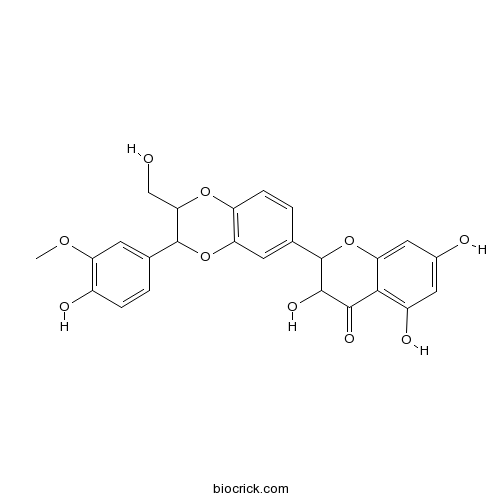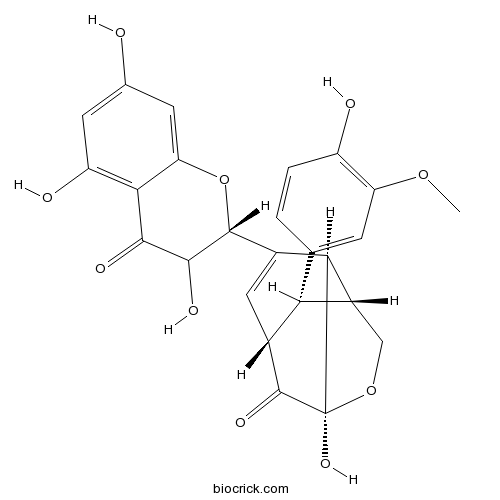Silybum marianum
Silybum marianum
1. The products in our compound library are selected from thousands of unique natural products; 2. It has the characteristics of diverse structure, diverse sources and wide coverage of activities; 3. Provide information on the activity of products from major journals, patents and research reports around the world, providing theoretical direction and research basis for further research and screening; 4. Free combination according to the type, source, target and disease of natural product; 5. The compound powder is placed in a covered tube and then discharged into a 10 x 10 cryostat; 6. Transport in ice pack or dry ice pack. Please store it at -20 °C as soon as possible after receiving the product, and use it as soon as possible after opening.
Natural products/compounds from Silybum marianum
- Cat.No. Product Name CAS Number COA
-
BCN6299
Silymarin22888-70-6
Instructions

-
BCN2388
Silydianin29782-68-1
Instructions

-
BCN2389
Silychristin33889-69-9
Instructions

-
BCN2406
Isosilybin72581-71-6
Instructions

Milk thistle (Silybum marianum): A concise overview on its chemistry, pharmacological, and nutraceutical uses in liver diseases.[Pubmed: 30080294]
Milk thistle (MT; Silybum marianum), a member of the Asteraceae family, is a therapeutic herb with a 2,000-year history of use. MT fruits contain a mixture of flavonolignans collectively known as silymarin, being silybin (also named silibinin) the main component. This article reviews the chemistry of MT, the pharmacokinetics and bioavailability, the pharmacologically relevant actions for liver diseases (e.g., anti-inflammatory, immunomodulating, antifibrotic, antioxidant, and liver-regenerating properties) as well as the clinical potential in patients with alcoholic liver disease, nonalcoholic fatty liver disease, viral hepatitis, drug-induced liver injury, and mushroom poisoning. Overall, literature data suggest that, despite encouraging preclinical data, further well-designed randomized clinical trials are needed to fully substantiate the real value of MT preparations in liver diseases.
Antiviral activity of silymarin against Mayaro virus and protective effect in virus-induced oxidative stress.[Pubmed: 30076863]
Mayaro virus (MAYV) is a neglected arbovirus belonging to the family Togaviridae. Its infection leads to Mayaro fever, with clinical manifestations such as fever, myalgia, headache, rash, arthralgia, vomiting, and diarrhea. The most prominent complaint from infected person is the long-lasting arthritis/arthralgia. The treatment for Mayaro fever is mainly symptom-based and there are no vaccines or antiviral drugs currently available, thus, natural products with anti-MAYV activity may provide a potential alternative. Recent evidences suggest that oxidative stress plays an important role in MAYV infection and compounds capable of modulating oxidative stress could represent a novel therapeutic approach in modulating MAYV-associated oxidative cellular damage. Silymarin is a complex extracted of Silybum marianum, or milk thistle, and its major active compound is silybin, which has a remarkable biological effect. Its antioxidant and antiviral effects, including its antiviral activity against the Chikungunya virus (CHIKV), prompted us to think whether silymarin could also reduce the replication of the MAYV and restore the pro-oxidant/antioxidant balance in the context of MAYV infection, leading to reduced cellular oxidative stress. We assessed the antiviral activity and protective effect of silymarin against oxidative stress in MAYV-infected HepG2 cells. Cytopathic effect inhibition, viral replication, and plaque reduction assays were used to determine the anti-MAYV activity of silymarin. Additionally, we determined whether silymarin could reduce MAYV-induced oxidative cell damage. Briefly, silymarin exhibited potent antiviral activity against MAYV and reduced MAYV-induced ROS formation and levels of malondialdehyde (MDA) and carbonyl protein, which are biomarkers of oxidative stress. In conclusion, the ability of silymarin to inhibit MAYV replication and attenuate MAYV-induce oxidative stress warrants further investigation of this compound as a novel therapeutic approach to Mayaro fever disease.
Protective Role of Silymarin in Early Doxorubicin induced Cardiac dysfunction in Children with Acute Lymphoblastic Leukemia.[Pubmed: 30073931]
Acute lymphoblastic leukemia (ALL) is the most common childhood cancer constituting about one third of pediatric malignancies. Doxorubicin is a well- established chemotherapeutic agent for treatment of childhood ALL, but its efficacy is often limited by its related cardiotoxicity. Cardioprotection against doxorubicin- induced cardiotoxicity can be of great value, especially for children. Silymarin (SM), an extract from the Silybum marianum (milk thistle) plant, has potent antioxidant properties that can be helpful in preventing cardiotoxicity.
Milk thistle (Silybum Marianum) as an antidote or a protective agent against natural or chemical toxicities: a review.[Pubmed: 30033764]
Biological and chemical agents cause dangerous effects on human health via different exposing ways. Recently, herbal medicine is considered as a biological and safe treatment for toxicities. Silybum marianum (milk thistle), belongs to the Asteraceae family, possesses different effects such as hepatoprotective, cardioprotective, neuroprotective, anti-inflammatory and anti-carcinogenic activities. Several studies have demonstrated that this plant has protective properties against toxic agents. Herein, the protective effects of S. marianum and its main component, silymarin, which is the mixture of flavonolignans including silibinin, silydianin and silychristin acts against different biological (mycotoxins, snake venoms, and bacterial toxins) and chemical (metals, fluoride, pesticides, cardiotoxic, neurotoxic, hepatotoxic, and nephrotoxic agents) poisons have been summarized. This review reveals that main protective effects of milk thistle and its components are attributed to radical scavenging, anti-oxidative, chelating, anti-apoptotic properties, and regulating the inflammatory responses.


